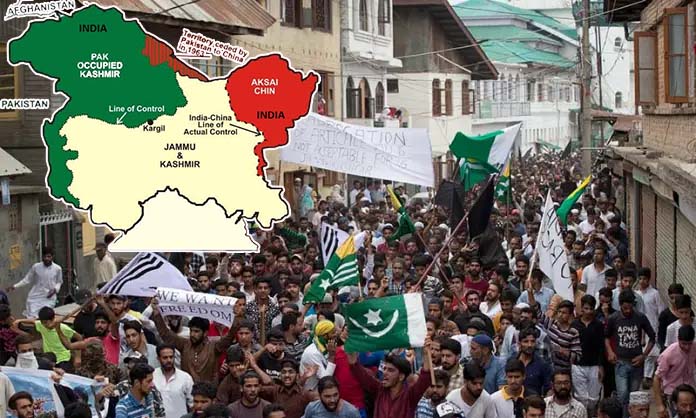
- The POJK remains central to the idea of territorial sovereignty of India, which is based on the legal accession of the princely state of Jammu and Kashmir to India in 1947.
- China’s involvement in POJK, particularly Gilgit-Baltistan, is mainly a matter of strategic and economic imperatives.
- The sufficient natural resources and potential for strategic hydropower exist, but POJK is economically marginalised.
- India’s reaction has been all-dimensional in the use of diplomatic, legal, economic, and security tools to protect its interests, endorse the rights of the population of POJK, and affirm its sovereignty over the region as per international law.
The Pakistan-Occupied Jammu and Kashmir (POJK) has come to occupy a sensitive place in the geopolitics of the Indian Sub-continent. The region is characterised by highly complex historical inheritance, deep strategic contestation between India, Pakistan, and China, and acute socio-economic and human-rights issues. The recent events of the Pahalgam attack by Pakistan and India’s response to it by “Operation Sindoor” have escalated the security environment and created an urgent need for a policy response from the Indian side, which should be restrained, calculated, and non-escalatory in nature.
Geostrategic and Political Importance
The POJK remains central to ideas of territorial sovereignty in India, which is based upon a legal accession of the princely state of Jammu and Kashmir to India in 1947. Pakistan’s occupation of the region through military aggression and subsequent rule of its occupying force thereby continues to be an infringement on the territorial integrity of India and international legal norms. For Pakistan, POJK is both a strategic cushion and a tool for the extraction of resources, but it is also a place for projecting influence in the Kashmir dispute. Its relevance was further enhanced by the involvement of China itself, most significantly through the China-Pakistan Economic Corridor (CPEC), which passes through Gilgit-Baltistan, thus affording Beijing strategic penetration of the Arabian Sea and increasing Beijing’s footprint around the area.
China’s Expanding Role
China’s involvement in POJK, particularly Gilgit-Baltistan, is mainly a matter of strategic and economic imperatives. CPEC (China-Pakistan Economic Corridor), a flagship policy of the Belt and Road Initiative, has seen significant investment in infrastructure and militarisation of Chinese territory, as well as a transfer of Chinese-origin land. This has intensified Indian security anxiety as well as accentuated the local irritants concerning population displacements, environmental destruction, as well as loss of autonomy. India has been rejected all third-party agreements on the status of Jammu and Kashmir always and that has sounded the illegitimacy of Chinese and Pakistani actions in the region.
Forced Demographic Change in Gilgit-Baltistan
Pakistan has purposefully driven demographic change in Gilgit-Baltistan. Without the implementation of the State Subject Rule that was abolished in 1984, the migration of non-indigenous populations, mainly Sunnis from other provinces, was facilitated, thus lessening the Shia inhabitants’ majority from 80% to about 39%. All these policies and land allotments to outsiders and the alienation of local communities have created great sectarian and ethnic rifts, and these have eroded the social structure of the region.
Economic Marginalisation and Neglect
The sufficient natural resources and potential for strategic hydropower exist, POJK is economically marginalized. The extraction of local resources by Pakistan, including water from the Neelum-Jhelum project, has not accrued to undue benefit to the indigenous people, who are confronted with chronic power shortages, poor infrastructure, as well as high unemployment rates. A variably opaque constitutional status prevents the area from experiencing politically meaningful representation, and economic planning thus continues to create cycles of poverty and underdevelopment.
Human Rights Violations and Local Opponents
The socio–political situation of POJK is fraught with the systematic violation of human rights such as forced disappearance, extrajudicial killings, political dissent suppression, and discrimination against women and minorities. Reporters and activists face harassment, detention, or exile for speaking up about them. Such intensification of land grabs, demographic engineering, and resource exploitation-often in partnership with Chinese interests-has triggered local protests on a large scale. Protests in cities like Muzaffarabad and Mirpur echo an increasing trend of seeking autonomy, economic rights, and the cessation of militarisation as well as state repression.
Security Dynamics: Pahalgam Attack and Sindoor Operation
The security environment in the area quickly deteriorated after a mass shooting on April 22, 2025, near Pahalgam against the Hindu tourists, leaving behind 26 dead and 20 wounded. The attack carried out by Lashkar-e-Taiba operatives is associated directly with Pakistan-based handlers and safe houses in Muzaffarabad and Karachi, underlining the continuing threat of cross-border terrorism. The attack was inappropriately orchestrated, according to Indian investigative agencies, by Pakistan’s Inter-Services Intelligence (ISI), spurring a structured counter-terrorist response.
In response, India carried out “Operation Sindoor”, a joint military campaign from the tri-services that targeted nine terrorist camps inside Pakistan and POJK, which include main hubs of Jaish-e-Mohammed and Lashkar-e-Taiba. Utilising high-accuracy weaponry such as loitering munitions, Indian forces destroyed terrorist infrastructure without escalating direct hostility with Pakistani forces. Pakistan retaliated by launching similar munitions at Jammu, promoting heightened military alertness and a blackout in many border areas.
The Way Ahead for India
India’s strategy towards Pakistan-occupied Jammu and Kashmir (POJK) should be guided by a pragmatic and long-term strategic approach against the backdrop of the Pahalgam attack and the subsequent response from the Government of India in the form of “Operation Sindoor”. India needs to redouble diplomatic efforts to embarrass Pakistan’s attitude towards supporting terrorism and human rights abuses in POJK. It must seek to increase traction on Islamabad through enhanced measures that add to military campaigns, such as suspension of trade and diplomatic isolation.
Militarily, India should continue to conduct sharp, highly intelligence-based operations against terrorist infrastructure in POJK and throughout Pakistan, with constant vigilance along the Line of Control and without undue escalation. At the same time, India should assist local people through humanitarian outreach and protection of their rights. Acknowledging the bounds of military action, India’s long-term policy should combine diplomatic, economic, and security tools to change Pakistan’s equation while not losing the emphasis on political settlement as the primary goal.
The policies of demographic engineering, economic exploitation, and political suppression by Pakistan have created deep-seated local resentment and instability. China’s increasing footprint only complicates the regional equation further. Recent Pahalgam attack, as well as India’s Operation Sindoor, bring out the security risks in the region. India’s reaction has been all-dimensional in the use of diplomatic, legal, economic, and security tools to protect its interests, endorse the rights of the population of POJK, and affirm its sovereignty over the region as per international law.
References:
- The Kashmir that India Lost: An Analysis of India’s Post-1980s Policy on Gilgit Baltistan- https://www.orfonline.org/research/the-kashmir-that-india-lost-an-analysis-of-india-s-post-1980s-policy-on-gilgit-baltistan
- Pakistan-occupied-Kashmir: An analysis of the Disputed Region- https://globalsouthseries.in/2022/08/16/pakistan-occupied-kashmir-an-analysis-of-the-disputed-region/
- Neglected regions: The socio-economic struggles of Pakistan-Occupied Jammu & Kashmir and Gilgit-Baltistan- https://www.opindia.com/2024/07/socio-economic-struggles-of-pakistan-occupied-jammu-kashmir-and-gilgit-baltistan/
- How Pakistan altered the demography of Gilgit-Baltistan- https://southasiamonitor.org/pakistan/how-pakistan-altered-demography-gilgit-baltistan
Parag Gilada is a Mukherjee Fellow who has recently graduated from the Jindal School of International Affairs with a keen interest in Sports Diplomacy. Views expressed are the author’s own.
